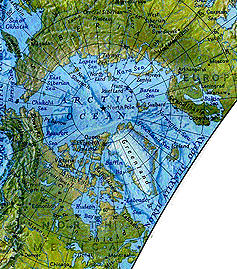
INTRODUCTION TO DATING
Archaeomagnetic Dating
In the early to mid 1960s, a new technique for dating archaeological material
emerged. this technique, known as archaeomagnetism, was introduced by Dr.
Robert Dubois. As applied, archaeomagnetism relies on thermo-remnant magnetism;
that is remnant of magnetic orientation is sediments that were once heated
sufficiently to alter their magnetic orientation toward magnetic north.
Clay, when heated, acquires a remnant magnetism with a direction paralleling
the earth's magnetic field. Once the clay cools, the fired clay hold that
magnetism until reheated. By knowing the date (by some other dating method)
of a feature and measuring the direction of magnetism in clays from this
feature, it is possible to determine the
ancient pole location (called the virtual geomagnetic
pole or VGP) of the earth's magnetic field at the time this clay was last
fired. When a large number of these ancient VGPs are dated through this
method, a composite curve of polar wandering (a VGP curve) can be reconstructed.
The VGP curve can be used then as a master record against which the VGPs
of samples of unknown age can be "dated". This implies that by
measuring the remnant magnetism from a clay sample from an archaeological
context, we can obtain a reference point relative to this curve and therefore
chronometrically date the context. (See
master curve in more detail.)

Measurement of the ancient magnetic field direction is made on pieces of
fired clay collected at archaeological sites in an oriented fashion. In
southern Arizona, people constructed what archaeologists call pithouses.
Pithouses tend to be roughly rectangular and dug into in the ground in shallow
pits thereby giving them their name. They typically had a clay lined hearth
immediately inside the entry. These are the source for archaeomagnetic samples.
Pieces of the baked clay are carefully isolated by carefully sawing them
from each hearth. A nonmagnetic, cube-shaped mold (made of aluminum) is
placed over the isolated column and filled with plaster. A record of magnetic
north and the vertical and horizontal placement of the sample are then made
and recorded on the sample recording sheet. Usually, eight to twelve of
these specimens are collected from the parameter of the hearth and submitted
for processing. The ancient magnetic direction and age determination for
a given feature is then calculated in a lab setting on the basis of the
mean direction of all specimens collected from the feature. The data are
then summarized and returned to the archaeologist for interpretation relative
to other data from the site.
Radiocarbon Dating
The basis for radiocarbon dating is magnificently simple. Carbon 14 is continuously
produced in the upper atmosphere by the action of cosmic rays, which set
free neutrons that transmute nitrogen in the air into radioactive carbon.
Incorporated in carbon dioxide, the radiocarbon moves through the atmosphere
and is absorbed by plants. animals in turn build radiocarbon into their
tissues by eating the plants. As long as they are alive, plants and animals
go on ingesting radiocarbon. When an organism dies, and ceases to take in
fresh carbon, its built-in clock begins to run down. The disintegrations
of its carbon-14 atoms tick away the seconds and the years: in 5,568 years
(on the average) only half of its original store of radiocarbon atoms is
left, and in another 5,568 years only half of those, or one quarter of the
original number.
Long before that time, of course, most plants and animals have decayed into
dust. but when the remains of an organism are fortuitously preserved, as
a house beam, a bit of charcoal, or a seed, the age of the remains can be
calculated. The amount of radiocarbon the organism possessed when it was
alive is known, and so is the rate of its radioactive disintegration. It
is easy to compute the age of the remains by counting the amount of radioactivity
that still remains.